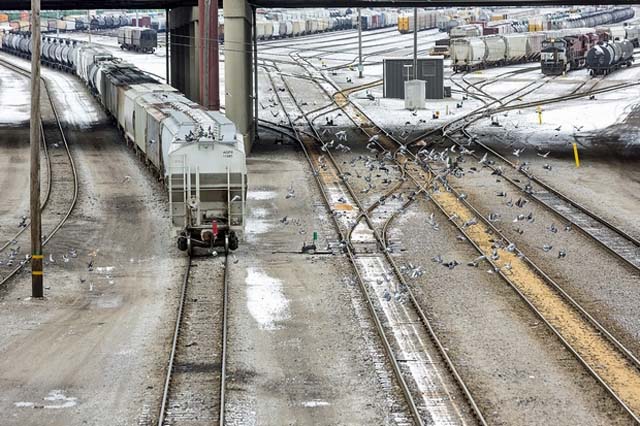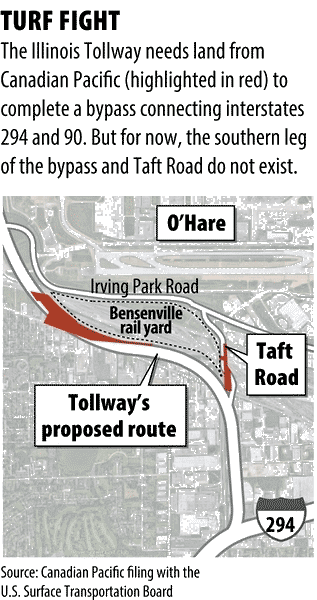

of its Bensenville Yard
Bensenville Illinois USA - The freight cars lining the rail yard tracks just south of O'Hare International Airport look from the air like the
braided stripes of a friendship bracelet.
Trains coming into Bensenville might be carrying potash from mines in Alberta bound for fertilizer plants, or auto parts from ships in Vancouver and headed for
Detroit's assembly lines.
The yard belongs to Canadian Pacific Railway (CP), nearly the runt of North America's seven largest railroads.
Bensenville is CP's only operating yard in Chicago, the heart of the North American railway system.
That fact goes a long way toward explaining why the railway has been locked for more than two years in an epic donnybrook with the Illinois Tollway over
whether the state agency can build a western access road to O'Hare that cuts through the yard.
CP declines to make an executive available for an interview.
Spokesman Jeremy Berry says in a statement that the railway "is not in a position at this point in time to discuss our Bensenville
operations."
But a 4 Jan 2018 letter to federal regulators signals the two sides may be close to a deal.
Their lawyers note for the first time the parties have made "significant progress toward reaching a settlement."
In filings with the U.S. Surface Transportation Board (STB), CP cites concerns about how the Elgin O'Hare Western Access project would affect its "ability
to expand in the future."
The risk for the Calgary, Alberta, railway is that ceding land means the yard can't accommodate as many rail cars, and with labour costs fixed, decreased
volume drops straight to the bottom line.
That would undermine future profits even as the railway's fortunes are on an upswing.
It posted a 58.2 percent adjusted operating ratio in 2017, the best in its history.
"They are in the situation where even giving away an inch could be the difference between success and failure," says Chicago rail consultant Jim
Giblin.
"It's not about expansion, it's about survival."
 Much of the Bensenville rail yard actually sits in Franklin Park.
Much of the Bensenville rail yard actually sits in Franklin Park.
Its 320 acres are bounded by Franklin Avenue and Green Street to the south and Irving Park Road to the north.
It handles traditional rail cars carrying coal and grain as well as intermodal traffic and containers moved by cranes from train to trucks.
It is, according to the railway's court filings, "arguably CP's most important real estate in its rail network."
About 800,000 rail cars and nearly 227,000 intermodal containers passed through the yard in 2015, the latest year for which data was available.
Between 2012 and 2015, intermodal traffic jumped 21 percent, after the railroad closed its Schiller Park yard and routed the traffic north.
It's cramped, designed for an era of steam engines and shorter trains, but still a major network hub.
Twenty-two percent of CP's freight traffic passes through Chicago, and nearly half the traffic exchanged to other railroads.
Unlike the trucking industry, which moves goods on the federally funded highway system, railroads own and maintain their infrastructure, and it needs to last
30 to 50 years.
They spent about 19 percent of revenue on capital investments in the last decade, compared to manufacturers' 3 percent.
But information on where and how customers will want to ship freight has a short shelf life, complicating long-term planning.
The industry is haunted by cautionary tales of railroads that gave up assets only to clamor for them back a decade later.
"They don't know exactly where the volume is going to come from, but it's clear all transportation is tight," says New York analyst and rail
consultant Anthony Hatch.
"The biggest challenge they face is how to speculate on their capital spending."
The Illinois Tollway's plans would make things even tighter.
It wants to build a toll road approaching O'Hare from the west and a bypass linking Interstate 90 north of the airport and Interstate 294 south of
it.
Building the southern leg of the bypass would take 36 acres from CP, or 11 percent of the yard.
CP was involved in planning for the toll road project starting in 2007 but cooled over time, according to the tollway's filings with the transportation
board.
In April 2010, the railroad's area real estate manager wrote to the Illinois Department of Transportation to say "the green light was granted to move
forward with this project."
Then at a July 2013 meeting, railroad representatives noted "new leadership", the late, famed, railroad CEO Hunter Harrison, "has shifted the
focus of the company to be more results driven and is very sensitive to operation impacts."
A year later, CP asked for US$114 million for the land, an "exorbitant" price, according to the tollway's filings.
In November 2015, it refused to sell altogether.
The tollway sued the railroad in November 2016.
Ostensibly, the tollway is asking the transportation board to decide a limited question, whether to build an interchange connecting the northern and southern
legs of the bypass.
But CP argues that it will lock the tollway into an alignment for the southern bypass that cuts across the yard, resulting in "considerable political
pressure on CP to cede sections of the yard."
When it comes to an intermodal terminal, the price matters less than whether there's land adjacent to the terminal to trade, says Jim Clewlow, chief investment
officer at Center Point Properties in Oak Brook.
The industrial real estate company has developed three train-to-truck yards in the Chicago area.
Selling land at an intermodal yard diminishes how many containers can be processed there, which affects the overall business.
"It doesn't shock me that CP is saying, how do we value this?"
Meanwhile, revenue increased 5 percent in 2017 to US$5.32 billion at CP.
Net income rose 50 percent to US$1.95 billion.
CEO Keith Creel, Harrison's handpicked lieutenant, told analysts in a 18 Jan 2018 call that "we're carrying that momentum into 2018, and this company
again is poised for another record-setting year."
Claire Bushey.
under the provisions in
Section 29 of the Canadian
Copyright Modernization Act.


